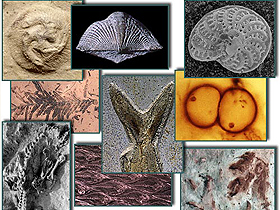Observational biological findings do not support the claim that different living things are descended from a common forebear, and it is paleontology, the study of fossils, which clarifies this fact. Evolution, they say, is a process that took place in the past, and our only scientific source of information about the history of life is fossil findings.
Naturalists must remember that the process of evolution is revealed only through fossil forms. . . Only paleontology can provide them with the evidence of evolution and reveal its course or mechanisms.175
According to the theory of evolution, living things are descended from one another. One living species already in existence gradually turned into another, with all species eventually coming into being in this way. According to the theory, this transition took place over hundreds of millions of years and proceeded in stages. That being the case, countless transitional forms should have appeared and persisted over a fairly lengthy time frame. (See Transitional Forms.)
Indeed, the number of these transitional forms should be even greater than that of the species we know of today. Darwin admitted that this represented an enormous difficulty for his theory in the chapter “Difficulties on Theory” of his book The Origin of Species:
Why, if species have descended from other species by fine gradations, do we not everywhere see innumerable transitional forms? Why is not all nature in confusion, instead of the species being, as we see them, well defined. . . . But, as by this theory innumerable transitional forms must have existed, why do we not find them embedded in countless numbers in the crust of the earth? . . . Why then is not every geological formation and every stratum full of such intermediate links? Geology assuredly does not reveal any such finely graduated organic chain; and this perhaps, is the most obvious and gravest objection which can be urged against my theory.176
The argument that Darwin proposed 140 years ago in the face of the absence of transitional form fossils—that there may be no transitional forms now, but these may be discovered through later research—is no longer valid. Today’s paleontological data show exceedingly rich fossil records. On the basis of the billions of fossils discovered in various regions of the world, some 250,000 different species have been described. They bear an extraordinary resemblance to the 1.5 million or so species alive today.177 It seems impossible that any transitional forms will be unearthed by new excavations, given the absence of any transitional forms so far in such a rich array of fossil specimens.
There is no need to apologize any longer for the poverty of the fossil record. In some ways it has become almost unmanageably rich, and discovery is outpacing integration. . . . The fossil record nevertheless continues to be composed mainly of gaps. 178
Niles Eldredge, the well-known Harvard University paleontologist, refutes Darwin’s claim that the fossil records are inadequate, which is why we are unable to find any transitional forms:
The record jumps, and all the evidence shows that the record is real: The gaps we see [in the fossil record] reflect real events in life’s history—not the artifact of a poor fossil record.179
Darwinists no longer claim the fossil record is not adequate on the account that fossil findings have almost provided all the samples. Main part of the earth is already examined and paleontology has put forward the truth that not “even one intermediary form” exists and living beings which existed for millions of years have “not changed” at all. Evolutionist writer Gordon R. Taylor describes this as follows:
One of the most astonishing features in the fossil record is the way in which new phyla have quietly appeared and carried on without making much impact for a while, and then have suddenly diversified into numerous life forms. This is called by paleontologists “explosive radiation”. (The word is used merely in its basic sense of lines radiating from a point.)180
This is true of all the thirty-two orders of mammals. . . The earliest and most primitive known members of every order already have the basic ordinal characters, and in no case is an approximately continuous sequence from one order to another known. In most cases the break is so sharp and the gap so large that the origin of the order is speculative and much disputed.... This regular absence of transitional forms is not confined to mammals, but is an almost universal phenomenon, as has long been noted by paleontologists. It is true of almost all classes of animals, both vertebrate and invertebrate . . . it is true of the classes, and of the major animal phyla, and it is apparently also true of analogous categories of plants.181
175 Pierre Grass8E, Evolution of Living Organisms, New York: Academic Press, 1977, p. 82.
176 Charles Darwin, The Origin of Species, pp. 172, 280.
177 David Day, Vanished Species, New York: Gallery Books, , 1989.
178 T. N. George, “Fossils in Evolutionary Perspective,” Science Progress, Vol. 48, January 1960, pp. 1, 3.
179 N. Eldredge and I. Tattersall, The Myths of Human Evolution, New York: Columbia University Press, 1982, p. 59.
180 Gordon Rattray Taylor, The Great Evolution Mystery, Abacus, Sphere Books, London, 1984, p. 82.
181 George G. Simpson, Tempo and Mode in Evolution, Columbia University Press, New York, 1944, pp. 105, 107.
182 D.S. Woodroff, Science, Vol. 208, 1980, p. 716.


